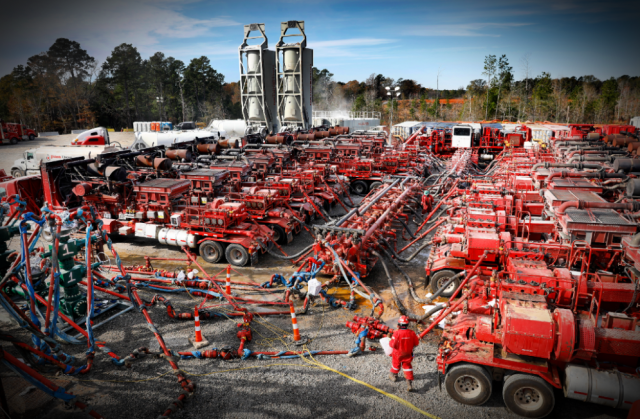
Halliburton is one of the big three service providers planning for a significantly leaner future. Pictured a Halliburton frac crew near Greenwood, La., in the Haynesville Shale in late 2017. (Source: Hart Energy)
As the U.S. shale boom sent the country’s crude production soaring over the past decade, the oilfield services companies that do everything from drilling producers’ wells and laying pipes to maintaining roads and operating software reaped big rewards.
But with the worst price crash in decades wreaking havoc on a sector that has booked tens of billions of dollars in write-downs over the past year, they are looking to turn away from the country in the clearest sign yet that the shale patch’s glory days may be over.
“North America is going to be a changed market moving forward,” said Lance Loeffler, CFO at one of the biggest services groups, Halliburton Co.. “Our view is that the international markets will take share back from a supply perspective… and we need to be prepared for that.”
As the pandemic sapped demand and prices plunged in recent months, listed U.S. oil producers slashed their capex by about 50%, according to Goldman Sachs. Most of that would have been spent on work carried out by oilfield services groups, whose revenues collapsed.
The big three service providers—Schlumberger Ltd., Halliburton and Baker Hughes Inc., which have a combined market cap of $55 billion—have taken write-downs of almost $45 billion over the past year. And even as activity picks up, they are planning for a significantly leaner future.
The U.S.—whose high-cost shale industry has been particularly badly hit by the price crash—has been at the heart of their efforts to cut costs and offload assets. Schlumberger, the biggest services group, said last week it had closed 150 North American facilities, while Halliburton said it had got rid of 100.
“They are having to right-size considerably …not only due to the implosion in activity but their belief that, effectively, the size of the industry and the rate of growth going forward in the United States is going to be considerably slower,” said Bill Herbert, an analyst at Simmons.
Global spending on oilfield services is set to slide by a quarter this year to $460 billion, according to consultancy Rystad Energy—worse than the 20% hit it took in the last downturn between 2014 and 2016. The slump will be greatest in North America, where shale drilling has dried up.
The sector accounts for the bulk of the roughly 115,000 jobs that have been lost in the U.S. oil and gas industry since the crash. Eighteen North American services companies filed for bankruptcy protection in the first six months of the year, according to Texas law firm Haynes & Boone—a number widely expected to rise.
Collapsed producers have left a string of often unsecured debts—meaning unmade payments not just to multinationals such as Schlumberger but also local mom-and-pop businesses providing welding or other basic services.
The turmoil has forced services companies to accelerate their strategic shift, under way since the last crash, to more stable international markets.
“Shale cannot continue to grow as it did,” said Audun Martinsen, head of oilfield services research at Rystad. “So you’re going to continue to see quite more…volatile activity in the U.S. That’s why the focus will be to be more exposed outside the U.S.”
Few in the industry expect the U.S. shale patch to return to anything near the growth rate of recent years, when the shale revolution drove an almost tripling of U.S. oil production between 2008 and the beginning of this year when it hit 13 million bbl/d.
“We’ve likely hit the bottom in North America. We think you’ll see a gradual, very small uptick in activity through the end of the year, with some more meaningful activity improvements in 2021,” said Paul Madero, vice-president of global drilling services at Baker Hughes.
“[But] we do not foresee—and I don’t think anyone would go out on a limb and say this—it returning any time soon to where it used to be.”
As they buckle in for a lengthy period of depressed prices and weak activity, services groups are looking to cut millions in structural costs over the coming months.
But with worries about peak oil in the background, their customers—oil producers—are also keeping their purse strings tightened.
“This downturn is quite severe,” Martinsen said. “Not only because of the bad second quarter that is being reported by companies but also how long it will take to really recover.”
“You're likely to see low prices for the next three years. So, it will take time for oil and gas companies to invest again.”
Recommended Reading
Column: There’s Methane to Our Madness
2024-01-30 - The EPA’s methane rule will likely face resistance—but it shouldn’t.
Qnergy Tackles Methane Venting Emissions
2024-03-13 - Pneumatic controllers, powered by natural gas, account for a large part of the oil and gas industry’s methane emissions. Compressed air can change that, experts say.
SEC Adopts Climate Disclosure Rules in 3-2 Vote
2024-03-06 - The regulation requires companies to disclose Scope 1 and 2 emissions, weather-related risks and other climate-related data that could have a material business impact.
MethaneSAT: EDF’s Eye in the Sky Targets E&P Emissions
2024-03-07 - The Environmental Defense Fund and Harvard University recently launched MethaneSAT, a satellite tracking methane emissions. The project’s primary target: oil and gas operators.
Exclusive: Scepter CEO: Methane Emissions Detection Saves on Cost
2024-04-08 - Methane emissions detection saves on cost and "can pay for itself," Scepter CEO Phillip Father says in this Hart Energy exclusive interview.





